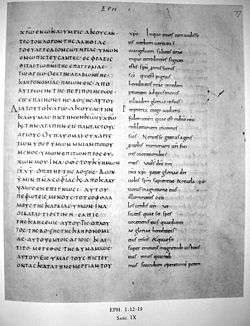- Codex Augiensis
-
New Testament manuscripts
papyri • uncials • minuscules • lectionariesUncial 010 Name Augiensis Sign Fp Text Pauline Epistles Date c. 850 Script Greek-Latin diglot Now at Cambridge Size 23 cm by 19 cm Type Western text-type Category II Codex Augiensis, designated by Fp or 010 (in the Gregory-Aland numbering), α 1029 (von Soden) is a 9th century diglot uncial manuscript of the Pauline Epistles in double parallel columns of Greek and Latin on the same page.[1]
Contents
Description
The codex contains 136 parchment leaves (23 cm by 19 cm), with some gaps in the Greek (Romans 1:1-3:19, 1 Corinthians 3:8-16, 6:7-14, Colossans 2:1-8, Philemon 21-25, Hebrews). Hebrews is given in Latin only. It is written in two columns per page, 28 lines per page.[1]
Text
Textual character
The Greek text of this codex is a representative of the Western text-type. According to Kurt and Barbara Aland it agrees with the Byzantine standard text 43 times, and 11 times with the Byzantine when it has the same reading as the original text. It agrees 89 times with the original text against the Byzantine. It has 70 independent or distinctive readings. Alands placed it in Category II.[1]
Textual features
In Romans 12:11 it reads καιρω for κυριω, the reading of the manuscript is supported by Codex Claromontanus*, Codex Boernerianus 5 it d,g, Origenlat.[2]
In 1 Corinthians 2:4 the Latin text supports reading πειθοι σοφιας (plausible wisdom), as 35 and Codex Boernerianus (Latin text).[3]
In 1 Corinthians 7:5 it reads τη προσευχη (prayer) along with
 11,
11,  46, א*, A, B, C, D, G, P, Ψ, 6, 33, 81, 104, 181, 629, 630, 1739, 1877, 1881, 1962, it vg, cop, arm, eth. Other manuscripts read τη νηστεια και τη προσευχη (fasting and prayer) or τη προσευχη και νηστεια (prayer and fasting) – 330, 451, John-Damascus.[4][5]
46, א*, A, B, C, D, G, P, Ψ, 6, 33, 81, 104, 181, 629, 630, 1739, 1877, 1881, 1962, it vg, cop, arm, eth. Other manuscripts read τη νηστεια και τη προσευχη (fasting and prayer) or τη προσευχη και νηστεια (prayer and fasting) – 330, 451, John-Damascus.[4][5]The section 1 Cor 14:34-35 is placed after 1 Cor 14:40, like other manuscripts of the Western text-type (Claromontanus, Boernerianus, 88, itd, g, and some manuscripts of Vulgate).[6][7]
Relationship to Codex Boernerianus
The Greek text of both manuscripts is almost the same; the Latin text differs. Also lacunae omissions are paralleled to the sister manuscript Codex Boernerianus. According to Griesbach Augiensis was recopied from Boernerianus. According to Tischendorf two codices were recopied from the same manuscript. Scrivener enumerated 1982 differences between these two codices. Among textual scholars, there is a tendency to prefer Augiensis above Boernerianus. The codex is also similar to Codex Claromontanus, and again scholars favour the readings in Augiensis above those in Claromontanus.
History
Codex Augiensis is named after the monastery of Augia Dives in Lake Constance.[8] In 1718 Richard Bentley (1662–1742) was its owner. The Greek text of the codex was edited by Scrivener in 1859.[9] It was examined, described and collated by Tischendorf.[10] E. M. Thompson edited a facsimile.[11]
The codex today is located in the library of Trinity College (Cat. number: B. XVII. 1) in Cambridge.[1]
See also
References
- ^ a b c d Aland, Kurt; Barbara Aland; Erroll F. Rhodes (trans.) (1995). The Text of the New Testament: An Introduction to the Critical Editions and to the Theory and Practice of Modern Textual Criticism. Grand Rapids: William B. Eerdmans Publishing Company. p. 110. ISBN 978-0-8028-4098-1. http://books.google.com/books?id=2pYDsAhUOxAC&printsec=frontcover&source=gbs_ge_summary_r&cad=0#v=onepage&q&f=false.
- ^ UBS3, p. 564.
- ^ UBS3, p. 581.
- ^ NA26, p. 450.
- ^ UBS3, p. 591.
- ^ NA26, p. 466.
- ^ Bruce M. Metzger, A Textual Commentary on the Greek New Testament (Deutsche Bibelgesellschaft: Stuttgart, 2001), pp. 499-500.
- ^ Gregory, Caspar René (1900). Textkritik des Neuen Testaments. 1. Leipzig: J.C. Hinrichs’sche Buchhandlung. p. 111. http://www.archive.org/stream/textkritikdesne00greggoog#page/n123/mode/2up.
- ^ Metzger, Bruce M.; Ehrman, Bart D. (2005). The Text of the New Testament: Its Transmission, Corruption and Restoration (4 ed.). New York – Oxford: Oxford University Press. p. 74. ISBN 978-0-19-516122-9.
- ^ K. Tischendorf, Anecdota sacra et profana ex oriente et occidente allata sive notitia, Lipsiae 1861, pp. 209-216.
- ^ Facsimiles of Manuscripts and Inscriptions, ed. E. A. Bond, E. M. Thompson and others I (London, 1873-1883), 127.
Further reading
- F. H. A. Scrivener, Contributions to the Criticism of the Greek New Testament bring the introduction to an edition of the Codex Augiensis and fifty other Manuscripts, Cambridge 1859.
- K. Tischendorf, Anecdota sacra et profana ex oriente et occidente allata sive notitia, Lipsiae 1861, pp. 209-216.
- W. H. P. Hatch, On the Relationship of Codex Augiensis and Codex Boernerianus of the Pauline Epistles, Harvard Studies in Classical Philology, Vol. 60, 1951, pp. 187–199.
External links
- Codex Augiensis F (010): at the Encyclopedia of Textual Criticism
- Codex Augiensis at the Trinity College Library Cambridge
- Cambridge Trinity B.17.1 high-resolution digital reproduction available at the St Gall Plan Project.
Categories:- Greek New Testament uncials
- Old Latin New Testament manuscripts
- 9th-century biblical manuscripts
Wikimedia Foundation. 2010.

